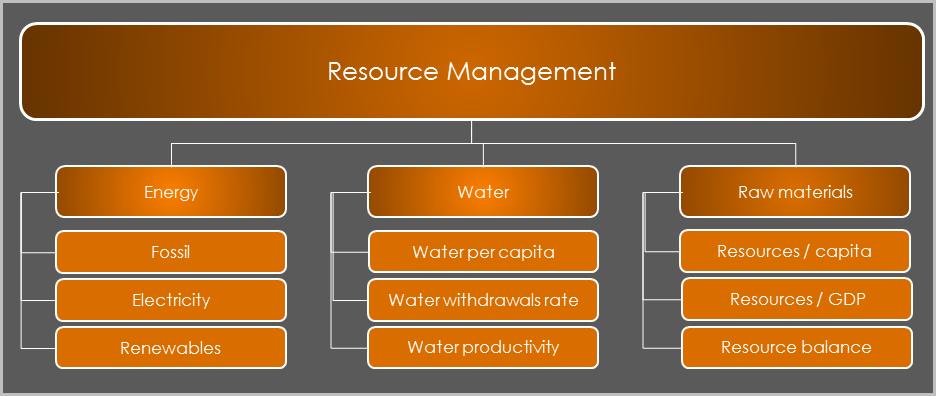
3 minute read
5 RESOURCE EFFICIENCY INDEX
Resource efficiency determines the ability to manage available resource (natural capital, human capital, financial capital) efficiently – regardless of whether the capital is scarce or abundant. Whether a country does or does not possess resources within its boundaries (natural and other resources), efficiency in using resources – whether domestic or imported - is a cost factor, affecting the competitiveness and thus wealth of nations. Over-exploitation of existing natural resources also affects the natural capital of the country, i.e. the ability of a country to support its population and economy with the required resources into the future.
In addition, non-renewable resources that are used today might be scarce and expensive tomorrow, affecting competitiveness, wealth and the quality of life in the future. A number of factors are pointing to rising cost for resources in the future, in particular natural resources: scarcity and depletion of energy, water, and mineral resources, increasing consumption (particular in non-OECD countries), financial speculation on raw materials, and possibly geo-political influences. The key objective of the resource management category is therefore to evaluate a country’s ability to deal with rising cost and sustain economic growth in the face of rising prices in the global commodity markets.
Advertisement
Vital natural resources include water, energy, and raw materials. Most of the resources used today are non-renewable, or only partly renewable: fossil-based energy, and minerals. Water aquifers and other natural products (e.g. wood) are renewable, as long as their capacity is not overused and the replacement patterns are not drastically altered, e.g. trough depletion, biodiversity loss, pollution, or climate change.
Resource efficiency indicators are evaluated both in terms of intensity (per capita) and efficiency (relative GDP). The availability of accurate global data is not as wide as in other criteria, particularly in terms of usage of raw materials. Other than steel & minerals usage, reliable raw material usage statistics are not available on a global level. The focus is therefore on energy, energy sources, water, steel usage, as well as GHG emission intensity and productivity. For the full list of indicators, refer to the methodology section.
Key elements of competitiveness drivers in the Resource Management Sub-Index
R e s o u r c e M a n a g e m e n t W o r l d M a p
The Resource Management Sub-Index is composed of indicators scored relative to population (e.g. GHG per capita) as well as relative to economic output (e.g. energy consumption per GDP). Indicators measured against population (per capita) clearly favour countries with low resource and raw material consumption (i.e. less developed countries), while indicators scored relative to GDP measure economic efficiency.
The resource intensity map shows that the resource intensity of less developed countries seems to be – generally speaking - lower than that of higher developed economies. However, indicators are measured both against economic output (GNI/GDP) and against per-capita performance. While the per-capita intensity is naturally lower in less developed economies, the per-output performance in efficient developed countries is lower than in the developing countries.
The resource intensity ranking 2020 is topped by Congo, followed by Kenya and Ethiopia – mainly due to low resource consumption. However, also highly developed economies achieve high rankings – Luxembourg (4), UK (5), Denmark (6)) and Ireland (7) are all ranked within the top ten. However, the World’s economic powerhouses are ranked significantly lower – Germany on 71, Japan on 133, the US on 117, and China on 158. The low rankings indicate a distinctive potential for improving sustainable competitiveness through reducing resource intensity and resource management – i.e. reducing costs, at the end of the day.
The main implications of higher or lower resource management capabilities are related to stability and sustained economic growth: should global prices for raw materials and energy rise significantly in the future (as trends and the majority of available research suggests), the countries in the lower ranks will face substantial higher costs and challenges to maintain their growth compared to countries with higher efficiency and intensity scores.

Resource Efficiency Index 2020

Social Capital Index











